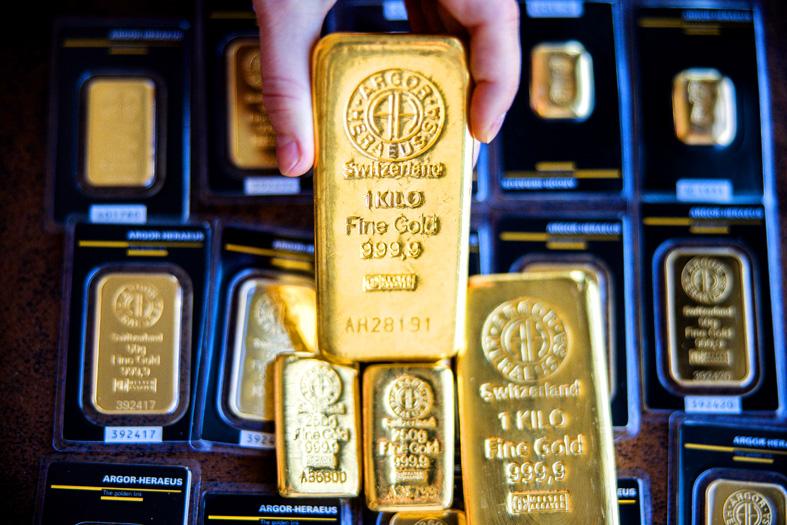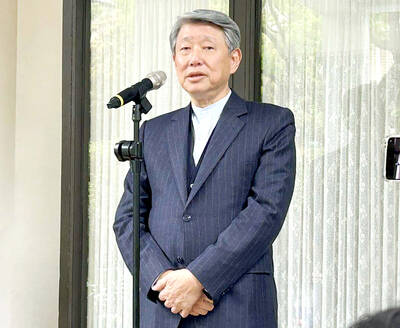Gold posted a second straight gain as investors weighed the impacts of new US sanctions on Russia and the outlook for economic growth.
The US is working with NATO allies to prepare for the possibility of Russia deploying biological, chemical or nuclear weapons as part of the Ukraine war, US National Security Adviser Jake Sullivan said on Thursday.
Meanwhile, a government report showed orders placed with US factories for business equipment unexpectedly declined last month for the first time in a year.

Photo: Bloomberg
The war in Ukraine and ensuing sanctions have pushed up commodity prices and fueled inflation, resulting in faster monetary tightening from some central banks while also threatening growth.
The US Federal Reserve’s more hawkish tone and higher US bond yields are weighing on non-interest bearing bullion, but gold is also benefiting from its appeal as a store of value.
Spot gold on Friday rose to US$1,958.32 an ounce in New York, up 1.3 percent for the week.
Silver and platinum advanced, and palladium was little changed.
Elevated inflation prints “and geopolitical uncertainty should drive gold modestly higher,” analysts at Morgan Stanley wrote in a note, forecasting US$2,000 an ounce in the second quarter of this year.
“We expect gold to come under pressure later in the year as central banks raise rates to combat inflation,” they said.
NICKEL
Nickel prices swung sharply in barely there volumes at the end of a tumultuous week on the London Metal Exchange (LME), in which futures spent most trading sessions locked either limit-up or limit-down.
Since reopening on March 16, Friday was only the second day that the nickel market remained within the LME’s new daily price limits as it seeks to reset after a massive short squeeze sent prices spiking.
However, the extreme lack of liquidity in the market has left it exposed to erratic moves — prices rallied more than 9 percent and then fell as much as 7.4 percent in just the first 45 minutes of trading.
The ongoing turmoil in the market is raising questions about the role and future of the LME as the place where benchmark prices are set for some of the world’s most important industrial metals.
The exchange has come under furious criticism for its handling of this month’s nickel crisis. Traders remain wary of the threat of another squeeze — there are still large short positions in the market that would have come under growing pressure during a two-day limit-up spike earlier in the week.
The LME suspended trading for a week and canceled billions of dollars of transactions earlier this month as it sought to rein in the runaway short-squeeze centered on China’s Tsingshan Holding Group Co (青山控股).
Trading has been effectively frozen for much of the time since the market reopened last week, with prices falling by a daily limit for several days. While the market saw some real trading on Tuesday, the price surged limit-up on Wednesday and Thursday.
Prices are still up 45 percent this month, set for the biggest gain since 1988, and the LME on Friday said it would nearly double the size of its default fund in response to the recent volatility.
Nickel was trading 5.5 percent lower at US$35,175 a ton on Friday, having earlier slumped by US$6,200 from its intraday high, in the second-biggest intraday swing on record, excluding trading on March 8.

MULTIFACETED: A task force has analyzed possible scenarios and created responses to assist domestic industries in dealing with US tariffs, the economics minister said The Executive Yuan is tomorrow to announce countermeasures to US President Donald Trump’s planned reciprocal tariffs, although the details of the plan would not be made public until Monday next week, Minister of Economic Affairs J.W. Kuo (郭智輝) said yesterday. The Cabinet established an economic and trade task force in November last year to deal with US trade and tariff related issues, Kuo told reporters outside the legislature in Taipei. The task force has been analyzing and evaluating all kinds of scenarios to identify suitable responses and determine how best to assist domestic industries in managing the effects of Trump’s tariffs, he

TIGHT-LIPPED: UMC said it had no merger plans at the moment, after Nikkei Asia reported that the firm and GlobalFoundries were considering restarting merger talks United Microelectronics Corp (UMC, 聯電), the world’s No. 4 contract chipmaker, yesterday launched a new US$5 billion 12-inch chip factory in Singapore as part of its latest effort to diversify its manufacturing footprint amid growing geopolitical risks. The new factory, adjacent to UMC’s existing Singapore fab in the Pasir Res Wafer Fab Park, is scheduled to enter volume production next year, utilizing mature 22-nanometer and 28-nanometer process technologies, UMC said in a statement. The company plans to invest US$5 billion during the first phase of the new fab, which would have an installed capacity of 30,000 12-inch wafers per month, it said. The

Taiwan’s official purchasing managers’ index (PMI) last month rose 0.2 percentage points to 54.2, in a second consecutive month of expansion, thanks to front-loading demand intended to avoid potential US tariff hikes, the Chung-Hua Institution for Economic Research (CIER, 中華經濟研究院) said yesterday. While short-term demand appeared robust, uncertainties rose due to US President Donald Trump’s unpredictable trade policy, CIER president Lien Hsien-ming (連賢明) told a news conference in Taipei. Taiwan’s economy this year would be characterized by high-level fluctuations and the volatility would be wilder than most expect, Lien said Demand for electronics, particularly semiconductors, continues to benefit from US technology giants’ effort

ASML Holding NV, the sole producer of the most advanced machines used in semiconductor manufacturing, said geopolitical tensions are harming innovation a day after US President Donald Trump levied massive tariffs that promise to disrupt trade flows across the entire world. “Our industry has been built basically on the ability of people to work together, to innovate together,” ASML chief executive officer Christophe Fouquet said in a recorded message at a Thursday industry event in the Netherlands. Export controls and increasing geopolitical tensions challenge that collaboration, he said, without specifically addressing the new US tariffs. Tech executives in the EU, which is